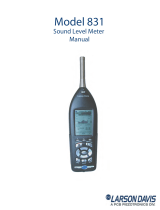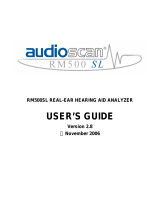
FIT THE BATTERIES
The CEL-62X Instrument requires three AA batteries. Remove the battery
compartment cover and fit the batteries observing correct polarity. Refit the
battery cover.
Note: The batteries can be zinc carbon, alkaline or rechargeable. Do not mix
battery types.
SWITCH ON
Press the ON/OFF Key - Figure 1 (3). Check the battery condition symbol
shows good charge.
After the initialisation screen the measurement screen will be displayed in the
STOP mode (red bar at the top and bottom of screen). Press the Menu Key to
access settings, memory and instrument status. The screen shown will be
dependent on if the CEL-62X series is a broadband (CEL-62XA) or if it is an
octave model (CEL-62XB or C).
SETTINGS SCREEN (Refer to Figure 2)
1 – SETTINGS / 2 – MEMORY RESULTS / 3 – INSTRUMENT STATUS /
A – BACK TO PREVIOUS SCREEN / B – MOVE TO NEXT SCREEN / C
NAVIGATION CURSORS
Figure 2 Settings Screen
SET LANGUAGE (Refer to Figure 2)
Select (1) Settings. Press (B) to continue. Use cursor keys (C) to select
Language symbol (4). Press (B) to continue. Use cursor keys (C) to select
Language. Press Select (B). Press Exit (A)
.
SET FREQUENCY MODE (Refer to Figure 2)
CEL-62XC models will allow selection of either octave or 1/3 octave with which
to take measurements. Select (1) Settings. Press (B) to continue. Use cursor
keys (C) to select Meter Mode symbol (5). Press (B) to continue. Use cursor
keys (C) to select Octave mode. Press Select (B). Press Exit (A)
.
SET TIME AND DATE (Refer to Figure 3)
Select (1) Settings. Press (B) to continue. Use cursor keys (C) to select Set
Clock symbol (2). Press (B) to continue. Press Edit (B) and use cursor keys (C)
to set the time. Press Save (B). Use cursor keys (C) to enable the date. Press
(B) to edit. Repeat to alter the date as required. Press Exit (A) when finished.
Figure 3 Set Time and date
CALIBRATE (Refer to Figure 4)
Fit the acoustic calibrator over the removable microphone and push it home.
Press the acoustic calibrator ON/OFF Key (1). The Instrument detects the
signal and activates the calibration screen (yellow bar). Press (B). The
Instrument will be calibrated and the word PASSED displayed. Press Exit (A) to
go back to the Stop screen. Press and hold the acoustic calibrator ON/OFF Key
to switch the calibrator off. Remove the acoustic calibrator.
Figure 4 Calibration Screens
SETUP (Refer to Figure 5)
On the SETTINGS screen, select (1) and press (B) to continue. Use cursor
keys (C) to select SETUP (2). Press (B) to continue. Use cursor keys (C) to
select the required measurement view for your local legislation. Refer to
Operator’s Manual for details on changing ‘User View’.
Figure 5 Settings Options
BACKLIGHT Refer to the Operator’s Manual for details.
RUN DURATION (Refer to Figure 6 and 7)
Use this feature if you require measurement runs of a set time duration. From
the SETTINGS screen use cursor keys (C) to select RUN DURATION (1).
Press (B) to continue. To edit ACTIVATION press Edit (B). Use cursor keys
(C) to make changes. Press Save (B) to continue.
Figure 6 Run Duration
Use cursor key (C) to enable DURATION and press Edit (B) to continue.
Use cursor keys (C) to set the Duration time. Press Save (B
).
Figure 7 Run Duration
CAL. REF. LEVEL (Refer to Figure 8)
Note this setting should only be accessed if using an acoustic calibrator
whose output level is not exactly 114.0dB. From the SETTINGS screen (see
Figure 2), use cursor keys (C) to select CAL.REF. LEVEL. Press (B) to
continue. The dB Level will be highlighted. Press Edit (B). Use the cursor
Keys (C) to edit the dB Level. Press Save (B) to go back to the Cal. Ref.
Level screen. Press Exit (A) to go back to Settings menu.
Figure 8 Cal. Ref. Level
MEMORY RESULTS (Refer to Figure 9 and 10)
From MENU screen, use cursor keys (C) to select MEMORY RESULTS (1)
and press (B) to continue. Use cursor keys (C) to select a Memory Result.
Press (B) to select measurement. Use cursor keys (C) to select VIEW
RESULTS (2) (See Figure 10 over page). Press Select (B) to continue. The
selected Memory Results are displayed. For additional data press View (B)
.
Figure 9 Memory Results
This screen displays detailed specific data for the saved Memory Results
(Figure 10). This is read only data. To view this data in a graphical format,
press View (B). The Octave values saved in the Memory Results are
displayed in a graphical format. Use cursor keys (C) to move the vertical
line across the graph. Each graph bar represents an octave level measured
in Hz or kHz. Press View (B) again to view tabular octave results.



